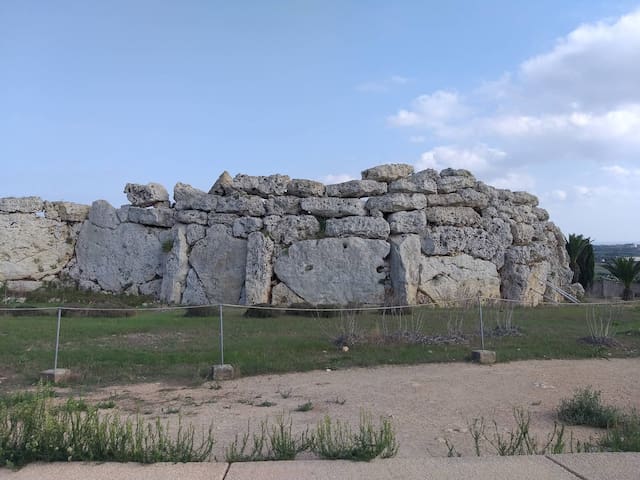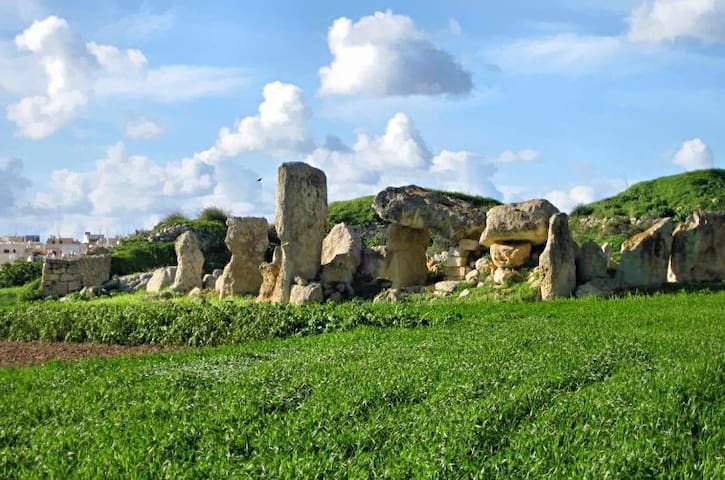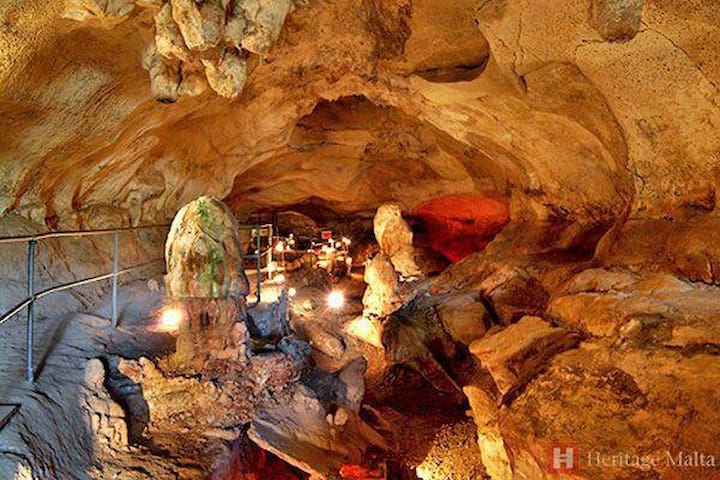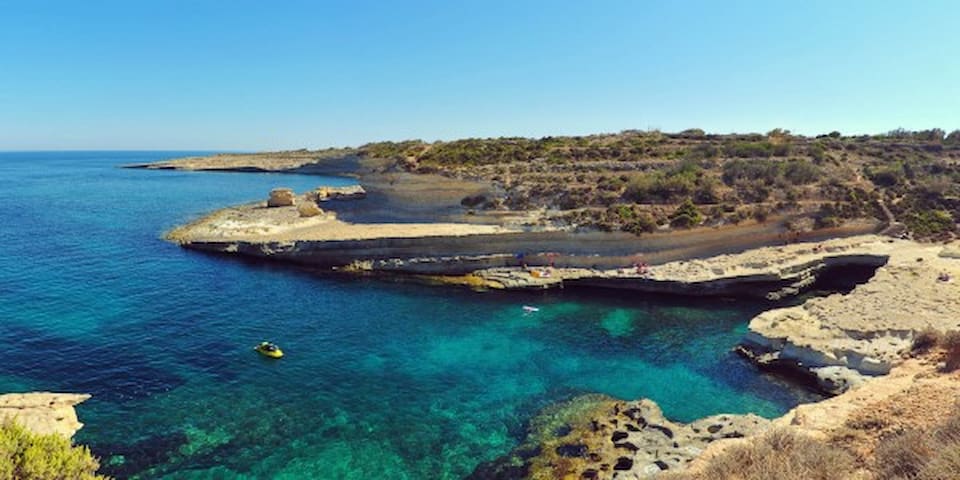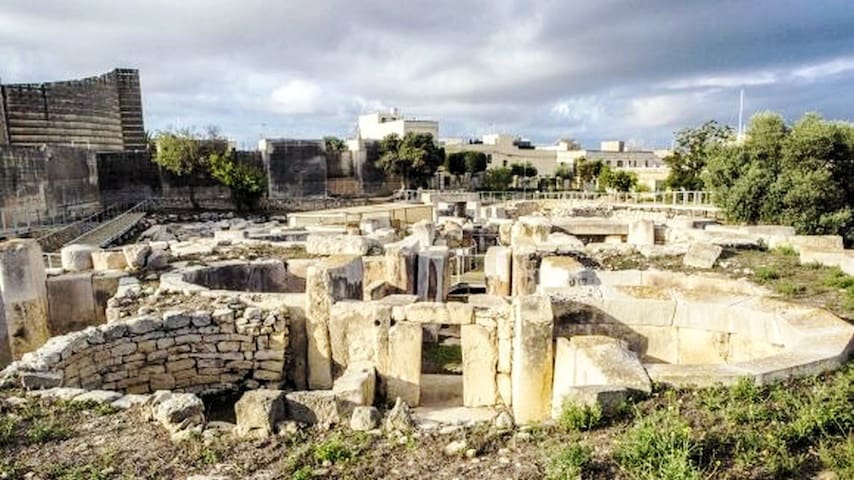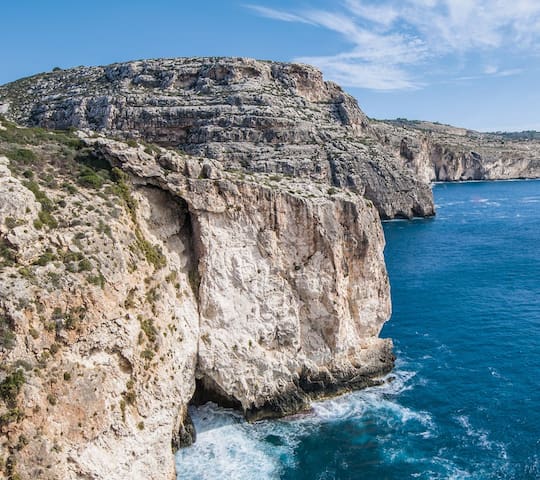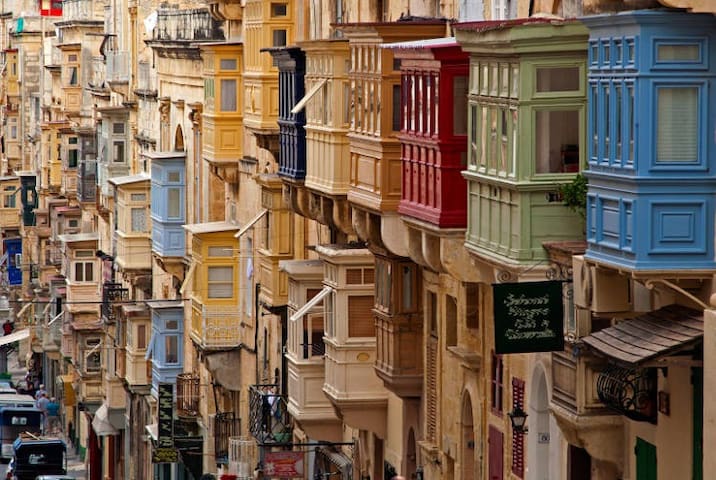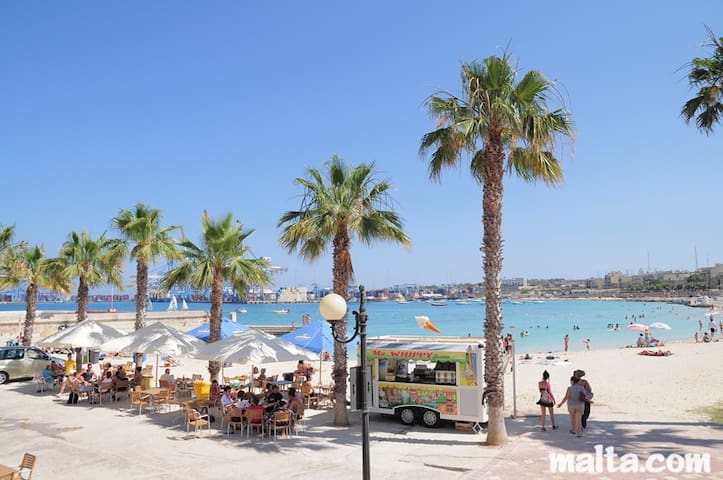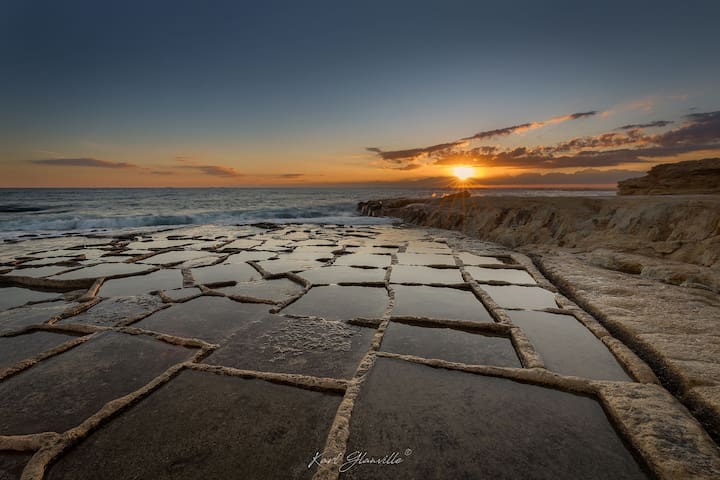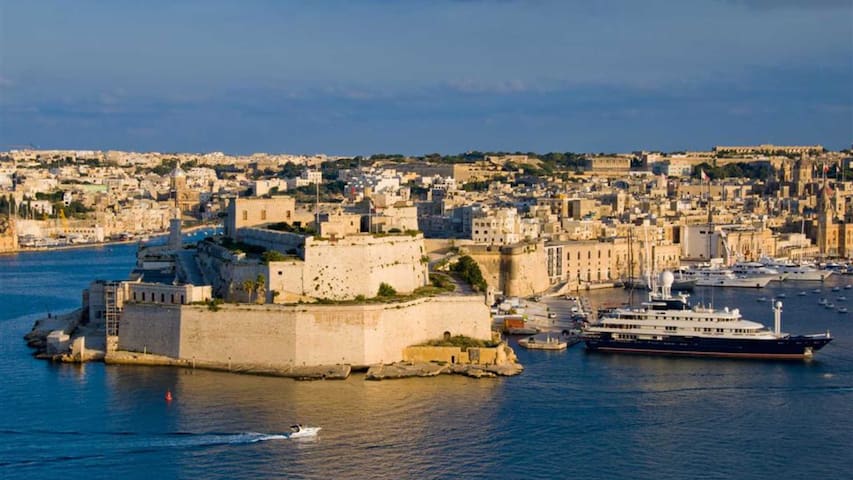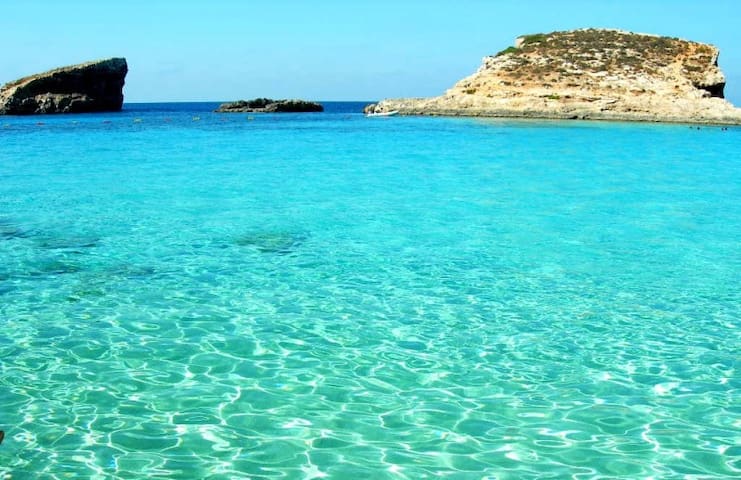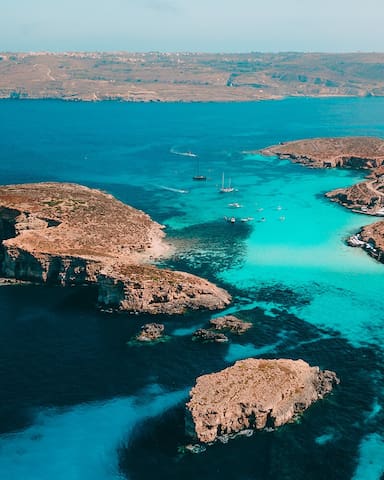Heritage Sites
The Maltese Islands have three sites inscribed on the UNESCO World Heritage List. These are the City of Valletta, the Megalithic Temples and the Ħal Saflieni Hypogeum.
In all, seven megalithic temples are found on the islands of Malta and Gozo, each the result of an individual development. The two temples of Ġgantija on the island of Gozo are notable for their gigantic Bronze Age structures. The Ġgantija Temples are the oldest, free-standing monuments in the world and are a testament to the Island's inhabitation for at least 1,000 years before the famous Egyptian pyramids of Giza were constructed.
On the island of Malta, the temples of Ħaġar Qim, Mnajdra and Tarxien are unique architectural masterpieces, given the limited resources available to their builders. The Ta' Ħagrat and Skorba complexes show how the tradition of temple-building was handed down in Malta. These temples were inscribed on the World Heritage List as a group and represent a unique architectural tradition that flourished on the Maltese Islands between 3600 and 2500 B.C.
The Ħal Saflieni Hypogeum is a rock-cut underground complex that was used both as a sanctuary as well as for burial purposes by the temple builders. It was discovered during construction works in 1902. The three underground levels date from around 3600 to 2400 B.C. The monument is considered one of the essential prehistoric monuments in the world.
The capital of Malta, Valletta, is inextricably linked to the history of the military and charitable Order of St John of Jerusalem. Built after the Great Siege of 1565 and named after Grandmaster Jean Parisot de la Valette, this fortified city has hundreds of monuments, all within a relatively small space, making it one of the most concentrated historic areas in the world.
The Ħal Saflieni Hypogeum is an underground prehistoric burial site, a complex made up of interconnecting rock-cut chambers set on three distinct levels. Earliest remains at the site date back to about 4000BC, and the complex was used over a span of many centuries, up to c. 2500 BC. The Hypogeum was first opened to the public in 1908. Due to its uniqueness, the site became very popular with visitors. Unfortunately, this had a negative impact on the delicate microclimate of the site. For this reason, a conservation project was conducted that also included the closure of the site for 10 years between 1990 and 2000. As a result of these studies, a new visiting system was established. Nowadays, only 10 visitors an hour are now allowed inside the Hypogeum for a maximum of 8 tours a day. This system is also complemented by an environmental control system which keeps temperature and humidity at required levels. Tickets for the Hypogeum should be purchased well in advance.
99 místní doporučují
Hypogeum Hal Saflieni
The Ħal Saflieni Hypogeum is an underground prehistoric burial site, a complex made up of interconnecting rock-cut chambers set on three distinct levels. Earliest remains at the site date back to about 4000BC, and the complex was used over a span of many centuries, up to c. 2500 BC. The Hypogeum was first opened to the public in 1908. Due to its uniqueness, the site became very popular with visitors. Unfortunately, this had a negative impact on the delicate microclimate of the site. For this reason, a conservation project was conducted that also included the closure of the site for 10 years between 1990 and 2000. As a result of these studies, a new visiting system was established. Nowadays, only 10 visitors an hour are now allowed inside the Hypogeum for a maximum of 8 tours a day. This system is also complemented by an environmental control system which keeps temperature and humidity at required levels. Tickets for the Hypogeum should be purchased well in advance.
Built before the famous standing stones at Stonehenge, the two temples making up this remarkable UNESCO World Heritage site have an extraordinary history. Built between 3600 and 3200 B.C, they fell into disuse around 2500BC and were not fully revealed to the modern eye until the nineteenth century.
The name Ġgantija derives from the word ‘ġgant’, Maltese for giant, as Gozitans used to believe the temples were built by a race of giants. Not so surprising when you see the size of the limestone blocks from which it is constructed. Some of these megaliths exceed five metres in length and weigh over fifty tons.
Hard-wearing coralline limestone is used for the construction of the outer walls (which is one of the reasons the buildings have survived so long) whilst softer, smoother, Globigerina limestone is reserved for inner furnishings such as doorways, altars, and decorative slabs. Each temple consists of a number of apses flanking a central corridor. There is evidence that internal walls would have been plastered and painted. Two plaster fragments marked with red ochre have been found and are now preserved at the Gozo Museum of Archaeology.
The temples have a large terrace at the front which would probably have been used for ceremonial gatherings. Remains of animal bones suggest some sort of ritual involving animal sacrifice and the use of fire is evidenced by the presence of stone hearths. A number of libation holes in the floor may have been used for the pouring of liquid offerings.
A small number of statuettes and other prehistoric objects found at Ġgantija can be seen in the Gozo Museum of Archaeology.
Accessible for persons with a disability.
155 místní doporučují
Ġgantija
Triq John Otto BayerBuilt before the famous standing stones at Stonehenge, the two temples making up this remarkable UNESCO World Heritage site have an extraordinary history. Built between 3600 and 3200 B.C, they fell into disuse around 2500BC and were not fully revealed to the modern eye until the nineteenth century.
The name Ġgantija derives from the word ‘ġgant’, Maltese for giant, as Gozitans used to believe the temples were built by a race of giants. Not so surprising when you see the size of the limestone blocks from which it is constructed. Some of these megaliths exceed five metres in length and weigh over fifty tons.
Hard-wearing coralline limestone is used for the construction of the outer walls (which is one of the reasons the buildings have survived so long) whilst softer, smoother, Globigerina limestone is reserved for inner furnishings such as doorways, altars, and decorative slabs. Each temple consists of a number of apses flanking a central corridor. There is evidence that internal walls would have been plastered and painted. Two plaster fragments marked with red ochre have been found and are now preserved at the Gozo Museum of Archaeology.
The temples have a large terrace at the front which would probably have been used for ceremonial gatherings. Remains of animal bones suggest some sort of ritual involving animal sacrifice and the use of fire is evidenced by the presence of stone hearths. A number of libation holes in the floor may have been used for the pouring of liquid offerings.
A small number of statuettes and other prehistoric objects found at Ġgantija can be seen in the Gozo Museum of Archaeology.
Accessible for persons with a disability.
The temple of Ħaġar Qim stands on a hilltop overlooking the sea and the islet of Fifla, not more than 2km south-west of the village of Qrendi. At the bottom of the hill, only 500m away, one finds the remarkable temples of Mnajdra. Both sites are included in the UNESCO World Heritage List.
165 místní doporučují
Hagar Qim
Triq Hagar QimThe temple of Ħaġar Qim stands on a hilltop overlooking the sea and the islet of Fifla, not more than 2km south-west of the village of Qrendi. At the bottom of the hill, only 500m away, one finds the remarkable temples of Mnajdra. Both sites are included in the UNESCO World Heritage List.
Mnajdra
Neighborhoods
Interesting places to visit in Birzebbugia and in the neighborhood.
Borg In-Nadur
Sqaq In-NadurJeskyně Ghar Dalam
Triq Ghar DalamSt Peter's Pool Marsaxlokk is another lovely beautiful natural peaceful inlet pool that is frequented by many tourists locals. It is an ideal location where you can relax away from the daily busy tourist areas. Located between Marsaxlokk fishing village and Delimara Point.
It is located in the south of Malta surrounded by the lovely blue deep waters and natural limestone rocks. It attracts swimmers for its crystal clear azure and light green colors and also offering ideal areas for snorkeling.
8 místní doporučují
St.Peter's Pool
St.Peter's PoolSt Peter's Pool Marsaxlokk is another lovely beautiful natural peaceful inlet pool that is frequented by many tourists locals. It is an ideal location where you can relax away from the daily busy tourist areas. Located between Marsaxlokk fishing village and Delimara Point.
It is located in the south of Malta surrounded by the lovely blue deep waters and natural limestone rocks. It attracts swimmers for its crystal clear azure and light green colors and also offering ideal areas for snorkeling.
A UNESCO World Heritage Site, the Tarxien Temples are inscribed as part of ‘The Megalithic Temples of Malta’ in the World Heritage List.
Tarxien
A UNESCO World Heritage Site, the Tarxien Temples are inscribed as part of ‘The Megalithic Temples of Malta’ in the World Heritage List.
Dingli walk starts near the Dingli cliffs and ends at Wied il-Zurrieq. En route to Wied il-Zurrieq, expect to see well-cultivated fields, cave openings, the Buskett Gardens, and Wardija Ta’San Ġorġ, a Bronze Age village. The hiking trail spans a distance of approximately 11.2 km.
20 místní doporučují
Ħad-Dingli
Dingli walk starts near the Dingli cliffs and ends at Wied il-Zurrieq. En route to Wied il-Zurrieq, expect to see well-cultivated fields, cave openings, the Buskett Gardens, and Wardija Ta’San Ġorġ, a Bronze Age village. The hiking trail spans a distance of approximately 11.2 km.
Built in the 16th century, Valletta was the first planned city in Europe, expertly designed by the Knights of St John during their reign in Malta. 2. Valletta and its spectacular Grand Harbour are two of the nine UNESCO World Heritage Sites to be found in Malta.
594 místní doporučují
Valletta
Built in the 16th century, Valletta was the first planned city in Europe, expertly designed by the Knights of St John during their reign in Malta. 2. Valletta and its spectacular Grand Harbour are two of the nine UNESCO World Heritage Sites to be found in Malta.
Always bustling with activity, Pretty bay offers something for everyone including beach sport activities and nearby bars, cafes and kiosks.
One of the very few beaches located in the Southern region of Malta, in Birzebbugia, this beach has both a rocky area as well as a sandy area. Compared to other beaches in Malta, this bay is by far one of the largest.
40 místní doporučují
Pretty Bay
Always bustling with activity, Pretty bay offers something for everyone including beach sport activities and nearby bars, cafes and kiosks.
One of the very few beaches located in the Southern region of Malta, in Birzebbugia, this beach has both a rocky area as well as a sandy area. Compared to other beaches in Malta, this bay is by far one of the largest.
Delimara
San Tumas
Marsaskala
The small and picturesque fishing village of Marsaxlokk (pronounced marsa-schlock – meaning Southern Port) is located in the South Eastern part of Malta, adjacent to Żejtun, Marsaskala and Birżebbuġa.earby Birzebbugia region
192 místní doporučují
Marsaxlokk
The small and picturesque fishing village of Marsaxlokk (pronounced marsa-schlock – meaning Southern Port) is located in the South Eastern part of Malta, adjacent to Żejtun, Marsaskala and Birżebbuġa.earby Birzebbugia region
If you are going to visit the Blue Grotto, a boat trip to the caves is the best way to experience the true beauty of the area. Boat trips are usually available daily (weather permitting) with the duration of each trip being around 20 minutes.
Blue Grotto Avenue
Blue Grotto AvenueIf you are going to visit the Blue Grotto, a boat trip to the caves is the best way to experience the true beauty of the area. Boat trips are usually available daily (weather permitting) with the duration of each trip being around 20 minutes.
Sightseeing
The Three Cities is a collective description of the three fortified cities of Birgu, Senglea and Cospicua in Malta. The oldest of the Three Cities is Birgu, which has existed since the Middle Ages. The other two cities, Senglea and Cospicua, were both founded by the Order of Saint John in the 16th and 17th centuries. The Three Cities are enclosed by the Cottonera Lines, along with several other fortifications. The term Cottonera is synonymous with the Three Cities, although it is sometimes taken to also include the nearby town of Kalkara.
52 místní doporučují
Valletta - 3 Cities Ferry
The Three Cities is a collective description of the three fortified cities of Birgu, Senglea and Cospicua in Malta. The oldest of the Three Cities is Birgu, which has existed since the Middle Ages. The other two cities, Senglea and Cospicua, were both founded by the Order of Saint John in the 16th and 17th centuries. The Three Cities are enclosed by the Cottonera Lines, along with several other fortifications. The term Cottonera is synonymous with the Three Cities, although it is sometimes taken to also include the nearby town of Kalkara.
Grand Harbour Hotel
Beaches
Beautiful beaches of our Maltese Island
On the tiny island of Comino, you will find the sheltered, dazzlingly blue waters of this small inlet, which has appeared on screen many times, most recently for a diving scene featuring Madonna in Swept Away and a spearfishing scene set in ancient times for the mini-series Helen of Troy.
Boat trips from Gozo and Malta to Comino enable you to take a dip in the lagoon. Also on Comino is St. Mary's Tower, which is featured in The Count of Monte Cristo.
122 místní doporučují
Modrá laguna
Triq KemmunetiOn the tiny island of Comino, you will find the sheltered, dazzlingly blue waters of this small inlet, which has appeared on screen many times, most recently for a diving scene featuring Madonna in Swept Away and a spearfishing scene set in ancient times for the mini-series Helen of Troy.
Boat trips from Gozo and Malta to Comino enable you to take a dip in the lagoon. Also on Comino is St. Mary's Tower, which is featured in The Count of Monte Cristo.
Fungus Rock
Dwejra Bay
Wied il-Għasri
Triq Is-SagħtrijaGħajn Tuffieħa
Comino
Doporučení související s městem
Nenech si ujít
museums
https://www.maltauncovered.com/museums/


